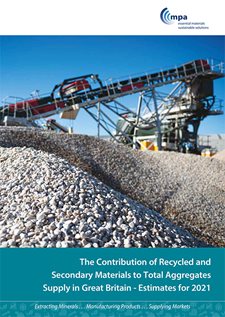 Twenty-eight per cent of Britain’s construction aggregates come from recycled and secondary sources according to a new report from the Mineral Products Association (MPA).
Twenty-eight per cent of Britain’s construction aggregates come from recycled and secondary sources according to a new report from the Mineral Products Association (MPA).
Demonstrating ‘circularity in action’ the study puts the spotlight on Britain’s biggest recycling success story – recovering construction waste to produce recycled aggregates, and processing industrial by-products into secondary aggregates – essential materials for housing, infrastructure, and public and private development.
The MPA says that total recycled and secondary materials accounted for nearly 70 million tonnes of the 253 million tonnes of construction aggregates supplied in Great Britain in 2021, a testament to the industry’s continued commitment to making the best use of available materials as part of the circular economy.
This also places Britain among the leading recyclers of construction materials in Europe, well ahead of other major economies, including France and Germany.
Recycled sources of aggregates, around 63 million tonnes of which were produced in 2021, mainly come from Construction, Demolition & Excavation Wastes (CDEW) such as crushed concrete and brick, old rail ballast and material from groundworks. Construction activity in built-up areas and on brownfield sites inevitably involves demolition work, generating waste materials which are processed for re-use as aggregates. In addition, during road maintenance work, the asphalt surface is planed off and can be re-used in new road surfacing.
Evidence shows that all construction and demolition wastes that are recovered and recycled as aggregates are being used in accordance with technical and safety standards. However, their contribution to total aggregates supply is ultimately limited by the volume of demolition activity that takes place.
Meanwhile, secondary sources of aggregates, which accounted for the remaining 7 million tonnes in 2021, are derived from industrial or extractive processes including the production of china clay, slate and chalk, plus glass reprocessing, mining spoil, incinerator ash, and slag from iron and steel production.
The Mineral Products Association is also concerned by the general paucity of regularly collected and compiled national statistics in this area. Whilst the MPA report attempts to address the data gap with the best information available, there is a clear need for more data to be made available through official Government sources, particularly given the challenges ahead with regards to circularity, sustainability and decarbonising all sectors of the economy to meet Net Zero target by 2050, and the need to set out more compelling evidence-based policy instruments.
Aurelie Delannoy, MPA Director of Economic Affairs who authored the report said: “Heavy-side construction materials producers have become adept at making efficient use of available resources, producing recycled and secondary aggregates that meet stringent requirements for use across different construction sectors. Taken together with the restoration of mineral extraction sites to beneficial after use – principally nature conservation – our industry is delivering sustainable environmental results whilst others just talk a good game.”
“The absence of regular data monitoring about material arisings and their use make it challenging to track the industry’s continuing progress and can fuel wider misunderstandings of the industry’s role in construction, both in terms of primary resource needs and the potential for greater use of materials that are either recycled or from secondary sources as part of the sector’s contribution towards green growth.”
Mark Russell, Executive Director at MPA said: “The contribution of recycled and secondary aggregates to total supply is an outstanding circular economy story that supports the UK’s green industrial revolution, the delivery of Government infrastructure and housing ambition, and the resilience of the UK construction supply chain by promoting a diverse source of supply.”
“Aggregates producers are recycling all available materials, and have been for many years, to meet our construction needs as efficiently and sustainably as possible. However, it is important to stress that primary aggregates are still needed to meet over 70% of total demand, a situation which will continue for the long term.”
The new MPA report “The Contribution of Recycled and Secondary Materials to Total Aggregates Supply in Great Britain - Estimates for 2021” can be viewed on the MPA website.
Ends.
About the Mineral Products Association:
The Mineral Products Association (MPA) is the trade association for the aggregates, asphalt, cement, concrete, dimension stone, lime, mortar and silica sand industries. With the merger of British Precast, and affiliation of the British Association of Reinforcement (BAR), the British Calcium Carbonate Federation, the Cement Admixtures Assocation (CAA), CONSTRUCT, Eurobitume, MPA Northern Ireland, MPA Scotland and the UK Quality Ash Association (UKQAA), it has a growing membership of 520 companies and is the sectoral voice for mineral products. MPA membership is made up of the vast majority of independent SME quarrying companies throughout the UK, as well as the 9 major international and global companies. It covers 100% of UK cement and lime production, 90% of GB aggregates production, 95% of asphalt and over 70% of ready-mixed concrete and precast concrete production. In 2018, the industry supplied £16 billion worth of materials and services to the Economy. It is also the largest supplier to the construction industry, which had annual output valued at £172 billion in 2018. Industry production represents the largest materials flow in the UK economy and is also one of the largest manufacturing sectors.
For media enquiries, contact Elizabeth Clements at: Elizabeth.Clements@mineralproducts.org